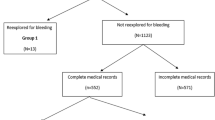Abstract
Background
We sought to quantify the effect of severe postoperative bleeding in hemodynamically stable patients following cardiac surgery.
Methods
We reviewed the charts of all cardiac surgery patients operated on at our institution between 2010 and 2014. After excluding patients with tamponade or MAP <60, we propensity matched patients having chest tube output >300 mL in the first postoperative hour, >200 mL in the second, and >100 mL in the third (“bleeding” group) with patients having <50 mL/h of chest tube output (“dry” group). The primary outcome was a composite of morbidity or mortality (excluding reexploration).
Results
5016 patients were operated on between 2010 and 2014; of these, we included the records of 84 bleeding and 498 dry patients. Propensity matching resulted in 68 pairs of patients well-matched on baseline and operative variables. As compared to matched dry patients, bleeding patients were more likely to experience the primary outcome of any morbidity/mortality (36.8 vs. 13.2 %, p = 0.002), as well as ventilation >24 h (33.8 vs. 7.4 %, p < 0.001) and 30-day mortality (11.8 vs. 1.5 %, p = 0.02). Of the 84 bleeding patients, 46 underwent reexploration for bleeding within 24 h of surgery. A subgroup analysis propensity matching bleeding patients who were or were not reexplored <24 h demonstrated similarly poor outcomes in each group (primary outcome, 44.7 % reexplored vs. 50.0 % non-reexplored, p = 0.65), though reexplored patients were far less likely to require hematoma evacuation/washout >24 h after surgery (0 vs. 18.4 %, p = 0.005).
Conclusions
Even among hemodynamically stable patients, severe bleeding is associated with markedly worse outcomes following cardiac surgery.

Similar content being viewed by others
Abbreviations
- ASD:
-
Absolute standardized difference
- BMI:
-
Body mass index
- CABG:
-
Coronary artery bypass grafting
- CI:
-
95 % confidence interval
- CT:
-
Chest tube
- CVA:
-
Cerebrovascular accident
- D/C:
-
Discharge
- EF:
-
Ejection fraction
- GFR:
-
Glomerular filtration rate
- IABP:
-
Intraaortic balloon pump
- ICU:
-
Intensive care unit
- IMA:
-
Internal mammary artery
- INR:
-
International normalized ratio
- NYHA:
-
New York Heart Association class
- OP:
-
Output (i.e., chest tube output)
- PVD:
-
Peripheral vascular disease
- SD:
-
Standard deviation
- STS:
-
Society for Thoracic Surgeons
References
Dacey LJ, Munoz JJ, Baribeau YR, et al. Reexploration for hemorrhage following coronary artery bypass grafting: incidence and risk factors. Northern New England Cardiovascular Disease Study Group. Arch Surg. 1998;133:442–7.
Karthik S, Grayson AD, McCarron EE et al. Reexploration for bleeding after coronary artery bypass surgery: risk factors, outcomes, and the effect of time delay. Ann Thorac Surg. 2004;78:527–34 (discussion 534).
Karkouti K, Wijeysundera DN, Yau TM, et al. The independent association of massive blood loss with mortality in cardiac surgery. Transfusion. 2004;44:1453–62.
Christensen MC, Dziewior F, Kempel A, et al. Increased chest tube drainage is independently associated with adverse outcome after cardiac surgery. J Cardiothorac Vasc Anesth. 2012;26:46–51.
Schotola H, Brauer A, Meyer K, et al. Perioperative outcomes of cardiac surgery patients with ongoing ticagrelor therapy: boon and bane of a new drug. Eur J Cardiothorac Surg. 2014;46:198–205.
Pham HP, Shaz BH. Update on massive transfusion. Br J Anaesth. 2013;111(Suppl 1):i71–82.
Spiess BD, Gillies BS, Chandler W, et al. Changes in transfusion therapy and reexploration rate after institution of a blood management program in cardiac surgical patients. J Cardiothorac Vasc Anesth. 1995;9:168–73.
Afshari A, Wikkelso A, Brok J et al. Thrombelastography (TEG) or thromboelastometry (ROTEM) to monitor haemotherapy versus usual care in patients with massive transfusion. Cochrane Database Syst Rev. 2011;CD007871.
Ak K, Isbir CS, Tetik S, et al. Thromboelastography-based transfusion algorithm reduces blood product use after elective CABG: a prospective randomized study. J Card Surg. 2009;24:404–10.
Wikkelso A, Lunde J, Johansen M et al. Fibrinogen concentrate in bleeding patients. Cochrane Database Syst Rev. 2013;8:CD008864.
Elizalde M, Slobodskoy L, Diodato M, et al. Use of recombinant factor VII in cardiac surgery. Recent Pat Cardiovasc Drug Discov. 2012;7:216–20.
Arnekian V, Camous J, Fattal S, et al. Use of prothrombin complex concentrate for excessive bleeding after cardiac surgery. Interact Cardiovasc Thorac Surg. 2012;15:382–9.
Dyke C, Aronson S, Dietrich W, et al. Universal definition of perioperative bleeding in adult cardiac surgery. J Thorac Cardiovasc Surg. 2014;147(1458–1463):e1.
Biancari F, Mikkola R, Heikkinen J, et al. Estimating the risk of complications related to re-exploration for bleeding after adult cardiac surgery: a systematic review and meta-analysis. Eur J Cardiothorac Surg. 2012;41:50–5.
Canadyova J, Zmeko D, Mokracek A. Re-exploration for bleeding or tamponade after cardiac operation. Interact Cardiovasc Thorac Surg. 2012;14:704–7.
Haneya A, Diez C, Kolat P, et al. Re-exploration for bleeding or tamponade after cardiac surgery: impact of timing and indication on outcome. Thorac Cardiovasc Surg. 2015;63:51–7.
Moulton MJ, Creswell LL, Mackey ME, et al. Reexploration for bleeding is a risk factor for adverse outcomes after cardiac operations. J Thorac Cardiovasc Surg. 1996;111:1037–46.
Acknowledgments
Dr. Magruder is the Irene Piccinini Investigator in Cardiac Surgery at Johns Hopkins. Dr. Crawford is the Hugh R. Sharp, Jr., Research Fellow in Cardiac Surgery at Johns Hopkins.
Author information
Authors and Affiliations
Corresponding author
Ethics declarations
Conflict of interest
The authors have no financial conflicts of interest to report, nor were there any funding sources for this work.
Rights and permissions
About this article
Cite this article
Magruder, J.T., Belmustakov, S., Ohkuma, R. et al. Attributable harm of severe bleeding after cardiac surgery in hemodynamically stable patients. Gen Thorac Cardiovasc Surg 65, 102–109 (2017). https://doi.org/10.1007/s11748-016-0714-4
Received:
Accepted:
Published:
Issue Date:
DOI: https://doi.org/10.1007/s11748-016-0714-4




